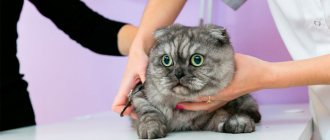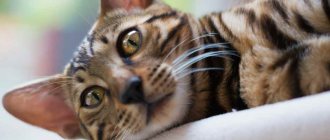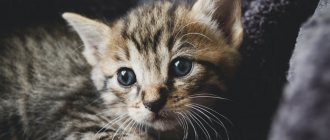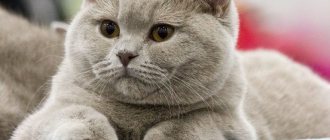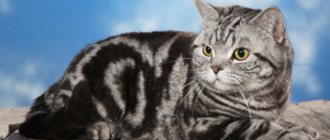Gingivitis
Gingivitis is an inflammation of the gums in a cat; in the initial stages it occurs as a mild disease.
But if you start the process, then not only the superficial layers of gum tissue are affected, but also the deeper ones. Inflammation affects the ligaments that hold the animal’s teeth in the socket, causing them to fall out. Symptoms:
- Excessive salivation is the very first characteristic sign of the disease; drool is usually viscous and hangs in the form of “icicles”. It is easy to detect in the initial stages of gingivitis in cats and begin treatment on time.
- Swelling – puffiness is a fairly noticeable symptom; the gums begin to “hang” over the teeth.
- Redness – the gums may also have whitish spots or be bluish in color. Upon examination, there will be a bright red stripe on the gums near the base of the teeth. Normally, cats have pale pink oral mucosa.
- Bleeding can be independent and constant, or detected by pressure.
- Strong unpleasant odor from the mouth.
- Severe pain - the cat reacts aggressively to an attempt to examine the mouth, begins to refuse food, and loses weight.
- With ulcerative gingivitis, characteristic ulcers appear on the gums; due to pain, the cat may refuse not only food, but also water.
Treatment:
1. Remove tartar and brush your teeth regularly.
2. Treat the oral cavity with herbal decoctions (oak bark, chamomile) or antiseptic solutions (miramestine, chlorhexidine).
3. Lubricate the gums with dental ointments (Zubastic or Dentavedin).
4. In case of severe inflammation, the veterinarian can prescribe the cat the antimicrobial and antiseptic agent Metrogyl Denta (active ingredients metronidazole benzoate and chlorhexidine gluconate). 5. To speed up the healing of gums, use oil solutions of vitamins A and E, rosehip or sea buckthorn oils, ointments with actovegin or solcoseryl (these substances activate tissue regeneration processes).
===========================================================================================================================================================================================
Why does a cat's mouth always remain open?
In a normal state, a healthy cat breathes through its nose, and opens its mouth only to meow, wash itself, bite or eat. If your pet regularly looks at you with its mouth open, you need to find out what is the reason for this behavior.
At the beginning of the article, we will take a short excursion into the physiology of cats.
As you know, cats have practically no sweat glands on their skin (except on the pads of their paws, and we can sometimes observe wet paws), so the excretory system in such animals works differently than in humans. Drainage from the eyes and ears begins, periodic but constant diarrhea and vomiting develop, and so on. In particular, shortness of breath may begin - chest or abdominal type. In addition to cases where the problem lies in the nasal cavity or in the oral cavity itself, an open mouth and breathing through the mouth is a protective-compensatory reaction of the body.
It is quite easy to diagnose the problem if a cause-and-effect relationship is visible: too hot weather or stress, travel by transport. In this case, the animal’s condition usually does not cause concern. It is more difficult if the symptoms appear suddenly and irregularly, or the owner simply does not pay attention to them for a long time and comes to the doctor when the disease has gone too far - complications appear, bad breath, severe salivation (salivation).
Possible causes of a cat breathing through its mouth
1. Diseases of the nasal and oral cavity: polyps, oronasal fistula, cleft palate, trauma, foreign bodies, periodontal and dental diseases, acne on the chin, mucosal ulcers due to infectious diseases and metabolic disorders. The mucous membrane is especially “burning” in cats that have been diagnosed with kidney problems or urolithiasis - this is again due to the characteristics of excretion.
2. Diseases of the respiratory and cardiovascular system: asthma, bronchopneumonia, pericarditis, myocarditis, trauma (diaphragm rupture), pleurisy, heart defects, neoplasms.
3. Non-communicable diseases of other organs and systems: tumors, injuries, acute dilatation of the stomach, crash syndrome, heat/sunstroke, pulmonary edema, cerebral edema, poisoning.
4. As a compensatory-adaptive mechanism during childbirth, stress, high temperature, physical activity.
5. Helminthiases with a development cycle through the lungs.
6. Congenital pathologies of the chest, trachea, heart.
We carefully study the pet
What should the owner pay attention to if he notices such a feature in his animal as breathing with an open mouth? Veterinarian at home 24 hours a day.
The cat should be observed for several days unless there is a clear threat to life. Answer yourself these questions:
- How often does this type of breathing occur?
- What could it be connected with, in your opinion?
- Does breathing appear after physical activity or at rest? Night or day?
- Is this type of breathing accompanied by coughing or vomiting?
- What is the general condition of the animal? Does the cat play, eat, drink, go to the toilet regularly or not?
At your appointment, your veterinarian may offer you a fairly long list of necessary tests, since you will need to rule out many diagnoses before getting to the truth.
For one of my patients, we searched for the cause of the cough for several months, going through all possible and impossible examinations... Diagnostics
So, if you go to the doctor complaining of open-mouth breathing, be prepared to be prescribed:
- clinical and biochemical blood test;
- consultation with a veterinarian-dentist;
- X-ray;
- Heart ultrasound and ECG;
- PCR for viral and infectious diseases that may be accompanied by such a symptom (for example, mycoplasmosis, chlamydia, herpes, rhinotracheitis);
- rhinoscopy and bronchoscopy;
- additional consultations with a veterinary surgeon and oncologist.
It would seem that the list is very large! In some medical institutions, people are not so meticulously checked... However, among the readers of the article, the majority are responsible, serious people who will always take care of their pets and support them during illness.
Tartar
In fact, tartar is the same plaque, which is a colony of microorganisms that has only undergone calcification. It is quite strong and hard, has a brownish tint and is capable of growing.
Symptoms:
- Finding dark yellow or brown growths on your cat's teeth.
- The appearance of bad breath.
- Bleeding and inflammation of the gums.
- Soreness may appear, the cat may begin to eat poorly, or even lose its appetite.
Treatment:
1. Grinding of teeth with a special paste. Used at the initial stage of the disease.
2. Tartar removal: mechanical or ultrasonic.
============================================================================================================================================================================================
Caries
The process of demineralization, accompanied by the destruction of the hard shell of the tooth and the formation of a cavity in its tissues, is called caries.
Caries occurs in several forms, which characterize the depth of damage to hard tissues:
- stage of a light spot (reverse development of the pathological process is possible for unknown reasons) - there are no changes in the structure of the tooth;
- superficial carious process - a dark pigment spot appears on the enamel, the enamel softens;
- with average carious lesions, enamel and dentin suffer;
- deep damage leads to complete damage to the tooth, affecting all its tissues, and attacks of acute pain are possible if hot or cold food comes into contact with the tooth; after the cessation of exposure to the temperature factor, the pain stops.
In the acute course of the pathological process, several teeth may be affected. In this case, the affected areas look like dirty gray spots.
Symptoms:
- decreased pet appetite;
- changes in the cat’s eating behavior (the animal may chew on one side or try to swallow food with minimal chewing movements);
- foul odor from the mouth;
- hypersalivation;
- change in color of the affected tooth;
- pain when chewing.
The cat cannot complain of pain, but will avoid any touching of the sore tooth.
Treatment:
1. At the initial stage, the veterinarian can use local antiseptics:
- silver nitrate;
- sodium fluoride.
2. If the damage is serious, the tooth is removed.
============================================================================================================================================================================================
Periodontal disease
Symptoms:
- Bad breath. One of the main reasons for visiting a veterinarian. The smell from the mouth becomes unbearable, putrid in nature, and can be felt from afar (when the animal enters the room).
- Decreased appetite. The cat wants to eat, but cannot. Refuses the once-favorite “crackers”, preferring soft food.
- Strange behavior. Owners notice how the pet shakes its head, rubs its muzzle with its paw, as if trying to get something out of its mouth. Sometimes you can clearly hear teeth grinding. The cat slurps when chewing. After eating, the lower jaw may tremble.
- Constant discharge from the mouth. A sick animal will drool profusely. Blood or pus may occasionally leak from the mouth. The fur on the chin is wet all the time, the skin becomes inflamed.
- Tartar and gum inflammation. If the cat is calm, you can move the upper lip and look into the mouth without opening its mouth. It is easy to notice yellow-brown tartar - massive hard deposits that sometimes completely cover the tooth itself. The gums are bright red or bluish in color and bleed. When pressed, a pus-like gray mass may come out from under it.
Treatment:
1. Hygienic cleaning of teeth from plaque and tartar at the initial stage of the disease. After this procedure, the crowns are coated with a fluoride-containing protective varnish. I treat the gums with antiseptic solutions and dental ointments (for example, Metrogil Denta).
2. Surgical intervention.
What diseases cause mouth ulcers in cats?
Diseases of various etiologies also cause ulcers in the mouth.
Stomatitis
Stomatitis in cats can be bacterial, viral or fungal. The infection is transmitted by contact or occurs without infection (due to a decline in immunity). Stomatitis can also be caused by diseases of the gastrointestinal tract.
In the cat's mouth there are small bubbles filled with transparent or white contents. They burst and ulcers form in their place. Stomatitis can be local or widespread.
Calcivirosis
Calcivirosis usually occurs in an acute form and is accompanied by fever.
The animal's temperature rises, symptoms similar to a cold appear (sneezing, watery eyes), and loss of appetite. Calciviral ulcers in the cat’s mouth begin to fester and emit a foul odor. The pet is wasting away before our eyes and if you don’t help it, it may die. The disease develops quickly.
This is a very dangerous and severe infection of viral origin. The disease affects not only the mouth, but also other mucous membranes, the respiratory system and virtually the entire body.
Feline herpes
A viral infection that affects the respiratory organs. The main symptom is small blisters that burst and turn into extensive erosions. Herpes appears not only in the oral cavity, but also on the outside - on the cat’s nose and lips. The disease is not so dangerous and does not pose a threat if treated in a timely manner.
Oncology
Squamous cell carcinoma most often occurs in the oral cavity of cats and dogs. Its main symptoms: ulcers and erosions in the mouth, excessive salivation, swelling of the muzzle, bleeding, unpleasant odor from the mouth, weight loss.
The disease is common in older cats. Practically untreatable.
Parasites
Various types of helminths affect the intestines, liver, and gall bladder. Their presence in the pet’s body has many symptoms: poor appetite, weight loss, bowel movements, respiratory symptoms (sneezing, drooling, watery eyes, red eyes).
Helminths produce toxins that cause poisoning of the body and allergic symptoms. Due to this, the mucous membranes become inflamed and ulcers, swelling, and reddening of the gums may appear in the cat’s mouth.

